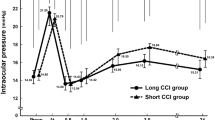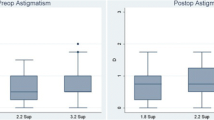Abstract
Purpose
To compare intraocular pressure (IOP) immediately after cataract surgery, and surgically induced corneal astigmatism (SIA) and corneal shape changes between eyes with transconjunctival single-plane sclerocorneal incisions (TSSIs) and eyes with clear corneal incisions (CCIs).
Methods
Bilateral eyes of 64 patients undergoing phacoemulsification were randomized to undergo 2.4-mm temporal TSSI or CCI. IOP was measured preoperatively, and in the immediate postoperative periods. SIA was determined using vector analysis, and corneal shape changes and irregular astigmatism were evaluated using a videokeratography preoperatively, and in the early postoperative periods.
Results
Wound hydration was performed in 23 eyes (35.9 %) of the TSSI group and in 60 (93.8 %) of the CCI group (P < 0.0001). Mean IOP was significantly higher in the TSSI group than in the CCI group at 30, 60, and 120 min postoperatively (P ≤ 0.0179). SIA tended to be smaller in the TSSI group than the CCI group, but the difference was not significant. The higher order irregular astigmatism was smaller in the TSSI group than in the CCI group at 2 days (P = 0.0312). The videokeratography revealed a wound-related flattening postoperatively in both groups; this change disappeared within 4 weeks in the TSSI group, whereas it persisted until 12 weeks in the CCI group.
Conclusion
IOP was significantly higher immediately after TSSI than after CCI and required less wound hydration, suggesting better stability with TSSI. Higher order irregular astigmatism and wound-related corneal flattening were smaller after TSSI than after CCI in the early periods, suggesting that fewer corneal shape changes with TSSI.





Similar content being viewed by others
References
Koch DD, Del Pero RA, Wong TC, McCulloch RR, Weaver TA. Scleral flap surgery for modification of corneal astigmatism. Am J Ophthalmol. 1987;104:259–64.
Shepherd JR. Induced astigmatism in small incision cataract surgery. J Cataract Refract Surg. 1989;15:85–8.
Ernest PH, McFarland MS, Siepser SB, Gills JP, Pollard A, Wang D, et al. Sutureless surgery to minimize astigmatism. In: Gills JP, Sanders DR, editors. Small-incision cataract surgery. Thorofare: Slack Inc.; 1990. p. 103–73.
Fine IH. Clear corneal incisions. Int Ophthalmol Clin. 1994;34:59–72.
Grabow HB. The clear corneal incisions. In: Fine IH, Fichman RA, Grabow HB, editors. Clear-corneal cataract surgery and topical anesthesia. Thorofare: SLACK Inc.; 1993. p. 29–60.
Kohnen T, Dick B, Jacobi KW. Comparison of the induced astigmatism after temporal clear corneal tunnel incisions of different sizes. J Cataract Refract Surg. 1995;21:417–24.
Leaming DV. Practice styles and preferences of ASCRS members—2003 survey. J Cataract Refract Surg. 2004;30:892–900.
McDonnell PJ, Taban M, Sarayba M, Rao B, Zhang J, Schiffman R, et al. Dynamic morphology of clear corneal cataract incisions. Ophthalmology. 2003;110:2342–8.
Taban M, Sarayba MA, Ignacio TS, Behrens A, McDonnell PJ. Ingress of India ink into the anterior chamber through sutureless clear corneal cataract wounds. Arch Ophthalmol. 2005;123:643–8.
Cooper BA, Holekamp NM, Bohigian G, Thompson PA. Case-control study of endophthalmitis after cataract surgery comparing scleral tunnel and clear corneal wounds. Am J Ophthalmol. 2003;136:300–5.
Taban M, Behrens A, Newcomb RL, Nobe MY, Saedi G, Sweet PM, et al. Acute endophthalmitis following cataract surgery: a systematic review of the literature. Arch Ophthalmol. 2005;123:613–20.
Lundström M, Wejde G, Stenevi U, Thorburn W, Montan P. Endophthalmitis after cataract surgery: a nationwide prospective study evaluating incidence in relation to incision type and location. Ophthalmology. 2007;114:866–70.
Hayashi K, Tsuru T, Yoshida M, Hirata A. Intraocular pressure and wound status in eyes with immediately after scleral tunnel incision and clear corneal incision cataract surgery. Am J Ophthalmol. 2014;158:232–41.
Gross RH, Miller KM. Corneal astigmatism after phacoemulsification and lens implantation through unsutured scleral and corneal tunnel incisions. Am J Ophthalmol. 1996;121:57–64.
Olsen T, Dam-Johansen M, Bek T, Hjortdal JØ. Corneal versus scleral tunnel incision in cataract surgery: a randomized study. J Cataract Refract Surg. 1997;23:337–41.
Hayashi K, Yoshida M, Hayashi H. Corneal shape changes after 2.0 mm or 3.0 mm clear corneal versus scleral tunnel incision cataract surgery. Ophthalmology. 2010;117:1313–23.
Sugai S, Yoshitomi F, Oshika T. Transconjunctival single-plane sclerocorneal incisions versus clear corneal incisions in cataract surgery. J Cataract Refract Surg. 2010;36:1503–7.
Hayashi K, Yoshida M, Manabe S, Yoshimura K. Effect of high versus normal pressurization on changes in intraocular pressure immediately after clear corneal cataract surgery. J Cataract Refract Surg. 2014;40:87–94.
Pakrou N, Gray T, Mills R, Landers J, Craig J. Clinical comparison of the Icare tonometer and Goldmann applanation tonometry. J Glaucoma. 2008;17:43–7.
Nakamura M, Darhad U, Tatsumi Y, Fujioka M, Kusuhara A, Maeda H, et al. Agreement of rebound tonometer in measuring intraocular pressure with three types of applanation tonometers. Am J Ophthalmol. 2006;142:332–4.
Scuderi GL, Cascone NC, Regine F, Perdicchi A, Cerulli A, Recupero SM. Validity and limits of the rebound tonometer (ICare®): clinical study. Eur J Ophthalmol. 2011;21:251–7.
Salim S, Du FH, Wan J. Comparison of intraocular pressure measurements and assessment of intraobserver and interobserver reproducibility with the portable ICare rebound tonometer and Goldmann applanation tonometer in glaucoma patients. J Glaucoma. 2013;22:325–9.
Brusini P, Salvetat ML, Zeppieri M, Tosoni C, Parisi L. Comparison of ICare tonometer with Goldmann applanation tonometer in glaucoma patients. J Glaucoma. 2006;15:213–7.
Sahin A, Basmak H, Niyaz L, Yildirim N. Reproducibility and tolerability of the ICare rebound tonometer in school children. J Glaucoma. 2007;16:185–8.
Munkwitz S, Elkarmouty A, Hoffmann EM, Pfeiffer N, Thieme H. Comparison of the iCare rebound tonometer and the Goldmann applanation tonometer over a wide IOP range. Graefes Arch Clin Exp Ophthalmol. 2008;246:875–9.
Jablonski KS, Rosentreter A, Gaki S, Lappas A, Dietlein TS. Clinical use of a new position-independent rebound tonometer. J Glaucoma. 2013;22:763–7.
Rao A, Kumar M, Prakash B, Varshney G. Relationship of central corneal thickness and intraocular pressure by iCare rebound tonometer. J Glaucoma. 2014;23:380–4.
Calladine D, Packard R. Clear corneal incision architecture in the immediate postoperative period evaluated using optical coherence tomography. J Cataract Refract Surg. 2007;33:1429–35.
Alpins NA. Vector analysis of astigmatism changes by flattening, steepening, and torque. J Cataract Refract Surg. 1997;23:1503–14.
Hayashi K, Yoshida M, Hayashi H. Postoperative corneal shape changes: microincision versus small-incision coaxial cataract surgery. J Cataract Refract Surg. 2009;35:233–9.
Hayashi K, Hayashi H, Oshika T, Hayashi F. Fourier analysis of irregular astigmatism after implantation of 3 types of intraocular lenses. J Cataract Refract Surg. 2000;26:1510–6.
Ernest PH, Lavery KT, Kiessling LA. Relative strength of scleral corneal and clear corneal incisions constructed in cadaver eyes. J Cataract Refract Surg. 1994;20:626–9.
Sarayba MA, Taban M, Ignacio TS, Behrens A, McDonnell PJ. Inflow of ocular surface fluid through clear corneal cataract incisions: a laboratory model. Am J Ophthalmol. 2004;138:206–10.
Herretes S, Stark WJ, Pirouzmanesh A, Reyes JM, McDonnell PJ, Behrens A. Inflow of ocular surface fluid into the anterior chamber after phacoemulsification through sutureless corneal wounds. Am J Ophthalmol. 2005;140:737–40.
Chawdhary S, Anand A. Early post-phacoemulsification hypotony as a risk factor for intraocular contamination: in vivo model. J Cataract Refract Surg. 2006;32:609–13.
May W, Castro-Combs J, Camacho W, Wittmann P, Behrens A. Analysis of clear corneal incision integrity in an ex vivo model. J Cataract Refract Surg. 2008;34:1013–8.
González Pérez J, Cerviño A, Giraldez MJ, Parafita M, Yebra-Pimentel E. Accuracy and precision of EyeSys and Orbscan systems on calibrated spherical test surfaces. Eye Contact Lens. 2004;30:74–8.
Read SA, Collins MJ, Iskander DR, Davis BA. Corneal topography with Scheimpflug imaging and videokeratography: comparative study of normal eyes. J Cataract Refract Surg. 2009;35:1072–81.
Acknowledgments
The authors thank SciTechEdit International (Highlands Ranch, CL, USA) for editorial assistance and Masahiro Toda, Ph.D. (CMIC Co., Ltd, Tokyo, Japan) and Kozi Yonemoto, Ph.D. (The Biostatistics Center, Kurume University, Kurume, Japan) for statistical assistance.
Author information
Authors and Affiliations
Corresponding author
Ethics declarations
Conflicts of interest
K. Hayashi, Grants (Alcon, Bayer Yakuhin, Wakamoto Pharmaceutical); S. Ogawa, Grants (Alcon, Bayer Yakuhin, Wakamoto Pharmaceutical); M. Yoshida, Grants (Alcon, Bayer Yakuhin, Wakamoto Pharmaceutical); and K. Yoshimura, Grants (Alcon, Bayer Yakuhin, Wakamoto Pharmaceutical).
About this article
Cite this article
Hayashi, K., Ogawa, S., Yoshida, M. et al. Wound stability and surgically induced corneal astigmatism after transconjunctival single-plane sclerocorneal incision cataract surgery. Jpn J Ophthalmol 61, 113–123 (2017). https://doi.org/10.1007/s10384-016-0480-y
Received:
Accepted:
Published:
Issue Date:
DOI: https://doi.org/10.1007/s10384-016-0480-y




